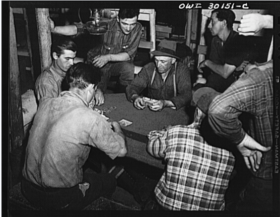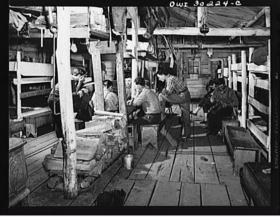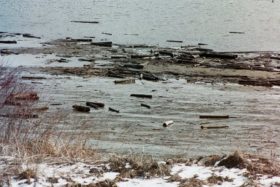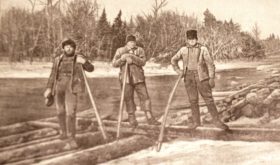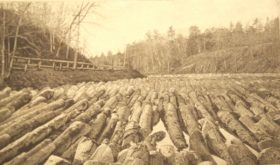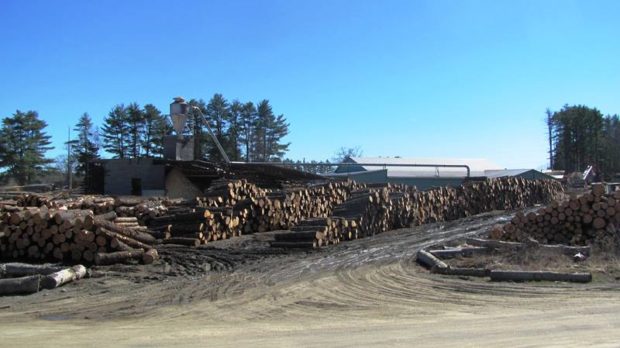
Hunt Sawmill in Jefferson (2012)
The cutting and moving of logs destined for lumber or paper was a tough, manual effort until the second half of the 20th century. Here is an eyewitness assessment by Louise Dickenson Rich of logging camp life in the 1940’s near Middle Dam in western Maine.
I also had to learn to differentiate between a day man, a stump cutter, and a member of the yarding crew. A day man gets paid by the day and does whatever the boss tells him to. He may cut firewood, swamp out roads, pile up brush and tops, anything.
Historic Logging Crew Members
Stump Cutter
A stump cutter it is an individualist. He works alone, felling his own trees, limbing them out, sawing them up into four-foot lengths, piling the pieces neatly for the convenience of the scaler and getting paid by the cord. . . . He’s usually pretty good. That’s why he works alone. He can make more money that way than he could by pooling his ability with that of someone else. . . .
Yarding Crew
A yarding crew consists of three men and a twitch horse. One of the men cuts down the trees and limbs them, one drives the twitch horse, dragging–or “twitching”–the entire of the trunk of the tree to a cleared space called a yard, where the third man saws it up with a buck saw and piles it. . . .
The Bosses
There’s the boss and the straw boss, who have their little shack, not because they feel exclusive, but because the men like to sit around the bunk-house in the evening and bellyache about the weather, the food, the administration of the camp, the way the trees grow, or any one of a thousand other things. The presence of authority would put a definite damper on this favorite of all indoor sports. . . . So the boss lives in his own little hut, dropping over occasionally to join in the poker game that runs continually from supper to bed-time and all day Sunday.
Office Workers
In another little hut, known as the Office, live the clerk and the scaler. The scaler, as the name implies, scales the wood for the men. That is, he estimates with the aid of a long marked rule called a scale rule the quantity each man cuts, keeps a record of the scale for the landowners, and reports each man’s cut to the clerk, who pays the man accordingly.
The clerk keeps the camp books, pays the men, orders supplies, tends the wangan–the little store where tobacco, candy, clothes, saw-blades and axes are sold–and runs the punch board*, which is always a part of the camp picture. The clerk and scaler are men of at least some education . . . .
Kitchen Crew
Behind a partition in the kitchen which is also the dining room, and which is by law a separate building, live the cook and his cookees, or helpers. They don’t mingle much with the rest of the camp. They’re too busy for one thing. For another they have their discipline to maintain. If arguments start they’re apt to start in the dining room. That’s one reason why no talking is allowed in the dining room, aside from simple requests to pass the butter please. And I mean “please.”. . .
Blacksmith
[The blacksmith] makes the sleds that are used to haul the wood, keeps the horses shod, repairs tools, and is usually an amateur veterinary besides. He and the feeder–woods for stableman–are responsible for the health of the horses. . . . The feeder waters and feeds the horses, cleans the stable, and keeps an eye on the pigs. Every lumber camp has five or six pigs. Every lumber camp also has cats. In the fall the cook brings in a cat to keep the kitchen free of mice and the stable free of rats that come in in the bales of hay.
Until 1976 the logs produced by this effort were dragged to a river and floated downstream to their destinations. Some were dragged across Moosehead Lake by the steamer Katahdin which was converted into a towboat for hauling pulpwood booms. Its logging career continued until 1976. [See Greenville] The 40-fot logging tugboat Kennebec worked on the Kennebec River and on Wyman Lake created by Wyman Dam on the river at Moscow. Built in 1956 at Katahdin Iron Works, it was retired in 1976 when the river log drives ended. After having a career along the Maine coast, in 2018 it arrived at the Lumbermen’s Museum in Patten.
Remnants of the river drives are still visible in many rivers. Logs frequently became truly “waterlogged” and sank to the bottom. Cribwork structures filled with rock linked booms that kept logs destined for a mill in the proper channel. Many of the piers remain.
Modern equipment have replaced the storied logging camps. The many tasks, people, horses, and camps have been exchanged for expensive, but efficient machines. See another logging video.
* a game of chance involving a board with many holes with slips of paper indicating a prize, or no prize, after paying to punch the slip out of the board
Additional resources
Forestry Forests of Maine Lumber Industry.
“From Stump to Ship.” Film. (Courtesy Northeast Historic Film.)
Collier, John Jr., 1913-1992. “Poker in Camp” c. 1943. Library of Congress Reproduction Numbers: LC-USW3-030151-C and LC-USW3-030224-C. http://www.loc.gov/pictures/search/. Speficically http://www.loc.gov/pictures/item/2017855681/ and http://www.loc.gov/pictures/item/2017855695/ (accessed December 10, 2017)
Cyr, Joseph. “Logging tugboat finds final home in Patton.” Houlton Pioneer Times. October 17, 2018. p. 1,6.
Redway, Jacques W. and Hinman, Russell. Natural School Geography. New York. American Book Company. 1907. (Source of 1905 photos.)
Rich, Louise Dickenson. We Took to the Woods. J.P. Lippincott. 1942. pp. 95-98.
See related articles: Lumber Industry, Pittston Academy Grant, Township C
“From Stump to Ship.” Film.


